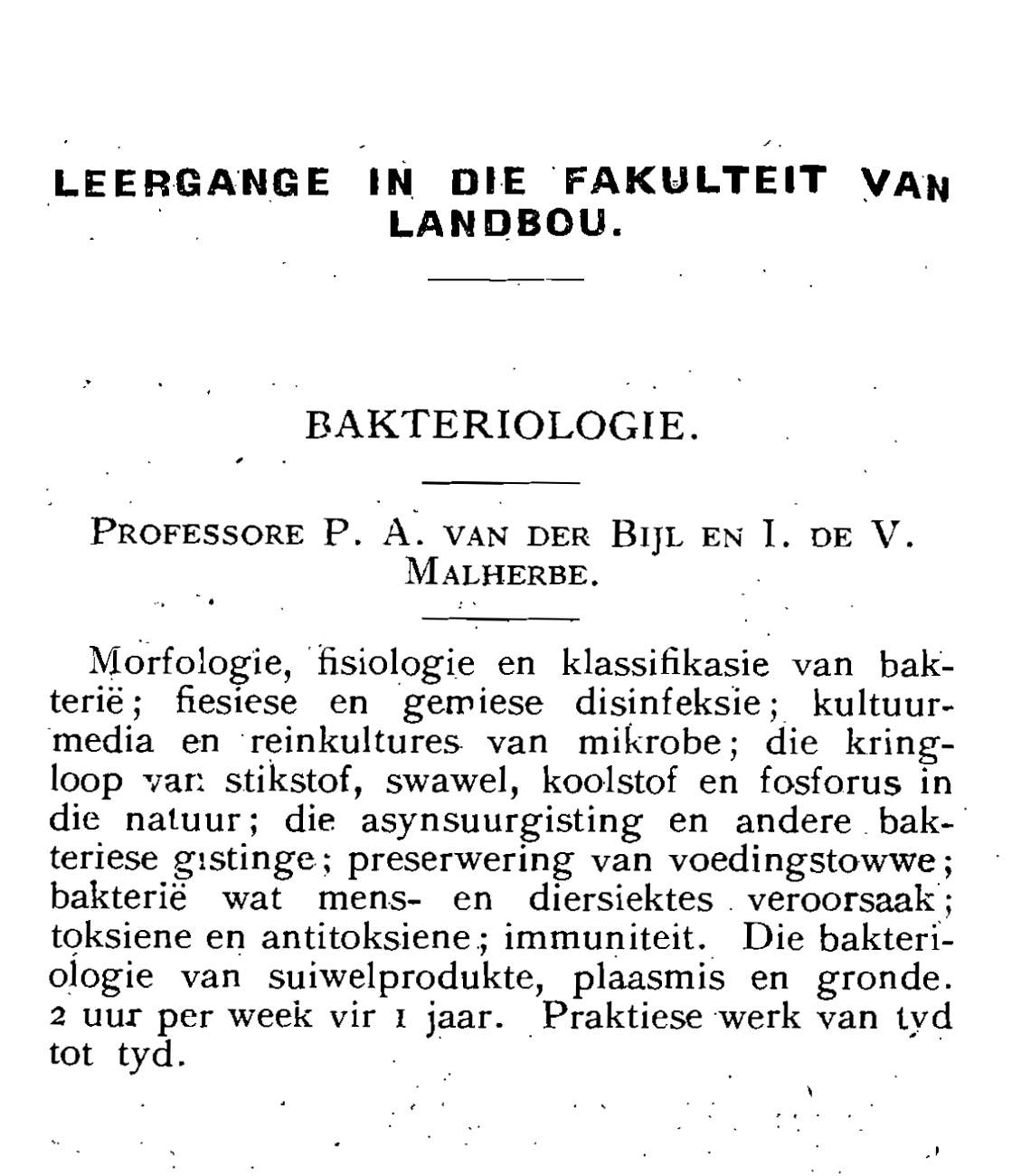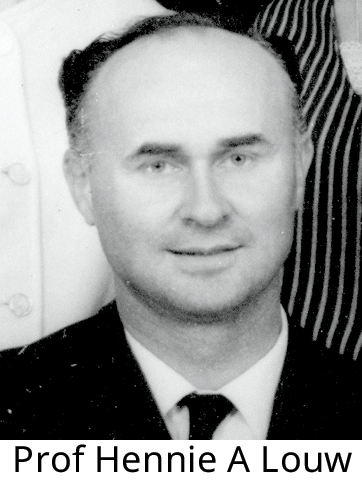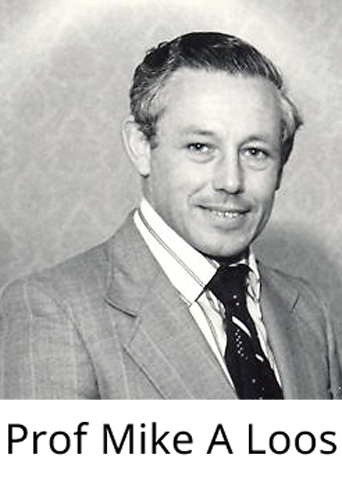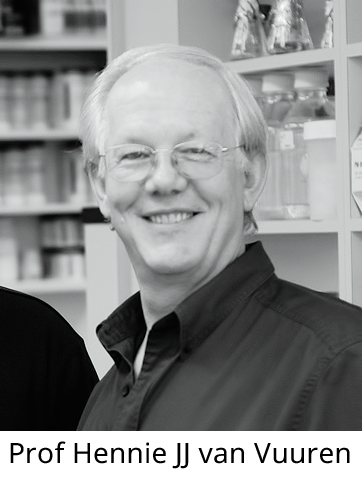1920's

| The first steps...
The establishment of the discipline of Microbiology at the University of Stellenbosch has its roots in Plant Pathology, which has been a field of specialty within the Faculty of Agriculture since 1918. Prof PA van der Bijl was appointed head of the newly formed Department of Plant Pathology in 1921. The name of the department changed to Phytopathology, and later to Plant Disease Studies. The first semester course in Microbiology, Introduction to Microbiology, was soon developed for agricultural students, followed by the service courses Soil Microbiology and Home Economics Microbiology. |   |
1950's
| 
| Microbiology becomes an Agriculture subject
The first step towards Microbiology as a graduate course was taken in 1949 by Prof SJ du Plessis, head of the Department of Plant Disease Studies. The introductory course in Microbiology was expanded with the inclusion of study material from learning institutions from the US and Britain. The Microbiology course was officially introduced as part of the BSc degree in Agriculture in 1951, with Chemistry as strong base. Prof Hennie A Louw, who would later become Dean of Agriculture, was the first enrolled student and obtained the degree of B.Sc. in Agriculture with a major in Microbiology in 1951. He was appointed the following year as a full-time lecturer / assistant technical officer in the Department of Plant Disease Studies and Microbiology. In 1958 he obtained a PhD in Microbiology with distinction from the University of Aberdeen, Scotland, and thereby became the first South African with a doctoral degree in this discipline. Prof SJ du Plessis was succeeded in 1953 by Prof AJ Louw as professor of Plant Pathology. |
1960's

| Establishment of the Department
In 1961 a decision by Senate to separate the fields of Plant Disease Studies and Microbiology was implemented. Prof AJ Louw was appointed Head of the Department of Plant Disease Studies and Professor Hennie Louw, Head of Department of Microbiology. Under Prof Louw's guidance the Department of Microbiology diversified and included courses in soil microbiology, virology and food microbiology. Misters NF Schoombee and MHV van Regenmortel was appointed as lecturers. Two researchers, three graduate technicians and two assistent-technicians was appointed as support staff. With the purchase of the first electron microscope Mr JS Hahn, former student of the Department of Microbiology, was sent to Germany for training and then appointed as first electron microscopist. The electron microscope was installed in the Paul van der Bijl laboratory on Welgevallen experimental farm.
Microbiology become a Natural Science subject
After negotiations with the Departments of Botany and Zoology, a pure BSc course in Microbiology as an inter-faculty degree course in the Faculty of Science was established in 1960. Prof MHV of Regenmortel was promoted to senior lecturer and then professor of Virology. With his appointment, the Department of Microbiology renamed to the Department of Microbiology and Virology . Starting 1963 the Honours BSc degree was instituted with Microbiology as one of the main fields of study. | 
Research gains momentum
Research in the Department of Microbiology and Virology initially focused on soil microbiology, food microbiology, problem-solving in the food industry and plant virology. The staff and students was since 1961 part of the Experimental Biology Group, a science discussion group of the Universities of Stellenbosch and Cape Town. Papers were published in local journals and internationally. |
1970's

| Changes from government
In 1973 the Government decided to separate the Stellenbosch Elsenburg Agricultural Faculty and the Elsenburg Agricultural College.
| Posts were rationalized, two departments were closed and the University of Stellenbosch took the Elsenburg Agricultural Faculty under its wing in 1975, with the Department of Microbiology and Virology included. Prof MHV van Regenmortel shortly afterwards retired and virology division was management for a short period by Dr M B von Wechmar of the Department of Plant Disease Studies.
Prof Mike A Loos succeeded Prof Hennie Louw as Professor of Microbiology in 1975, after the latter was appointed as the first full-time dean of the Faculty of Agriculture. Mr NF Schoombee was promoted to senior lecturer in 1975. At the time, the Department of Microbiology was housed on the second floor of the JS Marais Building right next to the Agricultural Library and the Plant Virology division moved to the Paul van der Bijl building on the Welgevallen experimental farm.
|
| 1980's | Microbiology starts making an imprint
The Department of Microbiology experienced a boom since 1980. Dr D du Plessis was appointed in 1981 and Dr F Sirgel shortly thereafter in 1984. Prof Hennie JJ van Vuuren and Mr Leon MT Dicks joined the department in 1983, followed by Prof IS (Sakkie) Pretorius, Dr Petro Schumann and Mr Bernard JH Janse in 1987.
With the increase in student numbers, the demand increased for more laboratory space. A large lecture hall on the ground floor of the JS Marais building was turned into a laboratory and also served as a practical venue for undergraduate students. In 1985 the Agricultural Library moved to the central library and the space on the second floor were converted into a huge laboratory for undergraduate students.
| ...
The new facility on the second floor, equipped with a built-autoclave, walk-in incubator and cold rooms, was shared by Microbiology and Plant Pathology. Microbiology later moved to the third floor of the JS Marais building with research space shared with the Department of Genetics.
Plant Virology was abolished as a field of study in 1986 and the Department of Microbiology expand strongly in molecular microbiology. With generous financial support from the Anglo American Corporation, the Institute for Biotechnology, with Microbiology and Biochemistry as the main divisions and Prof Hennie JJ van Vuuren as Director of the Institute was established. The purpose of the institute was to develop course material in biotechnology and to establish a strong research program. Prof Sakkie Pretorius introduced the first course in Molecular Yeast Genetics and played an important role in the formulation of Afrikaans terminology for this new discipline. |
1990's

| New facilities places Microbiology in a leadership position
Prof Hennie Louw as Dean of the Faculty of Agriculture is succeeded in 1991 by Prof Martin J Hattingh, an alumnus of the Department of Microbiology and a member of the Department of Plant Disease Studies, and Prof WH (Emile) van Zyl joins at the department in 1992. With further increase in the number of students and staff there again arises an urgent need for research space, and in 1993 Microbiology moved to the fourth floor of the Home Economics (now Lombardi) building. Dr James Watson, recipient of the Nobel Prize for Medicine in 1962, opened the new facilities and received later the same year a US honorary doctorate. | Prof Hennie van Vuuren was appointed as departmental chairman in 1993 and subsequent years the department grew into the largest research department in the Faculty of Agricultural Sciences. In 1996, the Institute for Wine Biotechnology was established and several graduate students together with Prof Sakkie Pretorius moved to JH Neethling building. Due to a growing number of undergraduate and postgraduate students from the Faculty of Natural Sciences, the Department of Microbiology moves to the Faculty of Science in 1997 (with Prof Fritz JW Hahne as Dean) and contributes to major inputs into the establishment of the School of Biological Sciences.
After the departure of Prof Hennie van Vuuren in 1997, Prof Sakkie Pretorius served as acting chairman and Ms Marinda Viljoen was appointed as a lecturer. Prof DE (Doug) Rawlings joined in July 1998 as new chairman, followed by the appointment of Prof BA (Bernard) Prior same year. Dr A (Alf) Botha joined the department in 1999, followed by Dr GM (Gideon) Wolfaardt in 2000. At that time, the Department of Microbiology consisted of eight lecturers and 57 graduate students. |
2000's

| A new century and new generation
Due to the strong increase in student numbers the demand for more research space became evident. In March 2000, Microbiology moved to the third floor of the newly built JC Smuts Biology Building sharing the facilities with Biochemistry on the first floor and Genetics at the second floor. With the introduction of the course programs in 2000, the traditional BSc course with two majors is replaced with more outcome-based programs in Molecular and Cellular Biology, Microbial Diversity and Biotechnology. In 2001 there were about 510 undergraduate and 67 graduate students (28 PhD, 29 MSc, 2 MScAgric, 7 BScHons and 1 BScAgric IV) studying Microbiology.
| Dr HY (Hafizah) Chénia is appointed in 2003 while Prof Gideon Wolfaardt left the department in 2004. During the period 2000 to 2004 the department maintains a strong research profile and all the academic staff are in possession of National Research Foundation (NRF) ratings of a very high average level (one A, four Bs, one C and Y). Dr Karin Jacobs joins the department in 2005, followed by Dr Heinrich Volschenk in 2007 after the retirement of Prof Bernard Prior. Ms Trudie Jansen was appointed as junior lecturer in 2008 and Dr Wesaal Khan as a senior lecturer in October 2011. Since 1999, several lecturers have also received ad hominem promotions, including Profs Van Zyl, Dicks, Botha, Bloom (né Viljoen) and Jacobs. While Prof Doug Rawlings acted as Dean of the Faculty of Science in 2007 and 2008, Prof Emile van Zyl acted as chairman of the department. The chairmanship is resumed by Prof Rawlings in January 2009 with the appointment of Prof. T. E. (Eugene) Cloete in 2009 as Dean of the Faculty of Science. |

